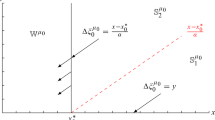Abstract
We consider the problem of how to optimally close a large asset position in a market with a linear temporary price impact. We take the perspective of an agent who obtains a signal about the future price evolvement. By means of classical stochastic control we derive explicit formulas for the closing strategy that minimizes the expected execution costs. We compare agents observing the signal with agents who do not see it. We compute explicitly the expected additional gain due to the signal, and perform a comparative statics analysis.
Similar content being viewed by others
References
Almgren, R., Chriss, N.: Optimal execution of portfolio transactions. J. Risk 3, 5–39 (2000)
Amendinger, J., Becherer, D., Schweizer, M.: A monetary value for initial information in portfolio optimization. Finance Stoch. 7(1), 29–46 (2003)
Amendinger, J., Imkeller, P., Schweizer, M.: Additional logarithmic utility of an insider. Stoch. Process. Appl. 75(2), 263–286 (1998)
Ankirchner, S., Dereich, S., Imkeller, P.: The Shannon information of filtrations and the additional logarithmic utility of insiders. Ann. Probab. 34(2), 743–778 (2006)
Ankirchner, S., Imkeller, P.: Financial markets with asymmetric information: information drift, additional utility and entropy. In Stochastic processes and applications to mathematical finance, pp. 1–21. World Sci. Publ., Hackensack (2007)
Baudoin, F.: Modeling Anticipations on Financial Markets. In Paris-Princeton Lectures on Mathematical Finance, 2002, Volume 1814 of Lecture Notes in Math, pp. 43–94. Springer, Berlin (2003)
Bertsimas, D., Lo, A.W.: Optimal control of execution costs. J. Financ. Markets 1, 1–50 (1998)
Corcuera, J.M., Imkeller, P., Kohatsu-Higa, A., Nualart, D.: Additional utility of insiders with imperfect dynamical information. Fin. Stoch. 8, 437–450 (2004)
Eyraud-Loisel, A.: Backward stochastic differential equations with enlarged filtration. Option hedging of an insider trader in a financial market with jumps. Stoch. Process. Their Appl. 115(11), 1745–1763 (2005)
Grorud, A., Pontier, M.: Insider trading in a continuous time market model. Int. J. Theor. Appl. Fin. 1(3), 331–347 (1998)
Hillairet, C.: Comparison of insiders’ optimal strategies depending on the type of side-information. Stoch. Process. Appl. 115(10), 1603–1627 (2005)
Ihara, S.: Information Theory for Continuous Systems. World Scientific Publishing Co., Inc., River Edge, NJ (1993)
Karatzas, I., Pikovsky, I.: Anticipative portfolio optimization. Adv. Appl. Probab. 28(4), 1095–1122 (1996)
Mansuy, R., Yor, M.: Random Times and Enlargements of Filtrations in a Brownian Setting, Volume 1873 of Lecture Notes in Mathematics. Springer-Verlag, Berlin (2006)
Schied, A.: A control problem with fuel constraint and Dawson-Watanabe superprocesses. Ann. Appl. Probab. 23(6), 2472–2499 (2013)
Schied, A., Schöneborn, T., Tehranchi, M.: Optimal basket liquidation for CARA investors is deterministic. Appl. Math. Finance 17(6), 471–489 (2010)
Acknowledgments
The authors thank anonymous referees for very useful comments. The first author gratefully acknowledges the financial support by the Ecole Centrale de Lyon during his visit in March 2012.
Author information
Authors and Affiliations
Corresponding author
Appendix
Appendix
The coefficients of the value function in Theorem 1 are given by
with \(t \in [0,T]\). We remark that Theorem 1 can be derived from Theorem 2 in [15]. The proof given below is completely different though, using classical verification arguments.
Proof of Theorem 1
Let \(w(t,x,s) = b(t) x^2 + c(t) xs + d(t)s^2 + e(t) x + f(t) s + g(t)\). We first show that the value function satisfies \(V \le w\). Notice that w is a solution of the HJB Eq. (4) and satisfies the terminal condition (5). This follows from the fact that the coefficients satisfy the following ODEs
Since the functions \(\alpha \) and \(\beta \) are bounded, there exists a constant \(C\in \mathbb {R}_+\) such that
for all \(t \in [0,T]\). Moreover, we have \(|b(t)| \le C\frac{1}{T-t}\).
Let \(\xi \in \mathcal {A}(t,x)\) be an arbitrary admissible control and let X be its associated position process. Let \(\tau < T\). Itô’s formula implies
where \(M_s = \int _t^s w_s(u,X_u,S_u) \sigma dW_u\). As \((X_t)_{t \in [0,\tau ]}\) is \(L^2\)-bounded and all functions b, c, d, e, f, g and their derivatives are bounded on \([t,\tau ], M\) is a strict martingale on \([t,\tau ]\). Taking expectations, therefore, leads to
As \(\xi \) is square integrable (Condition (A1)). This further implies that we have
Moreover, since also \(\left( \frac{X_t^2}{T-t}\right) _{t \in [0,T)}\) is uniformly integrable and \(\lim _{t \rightarrow T}\frac{X_t^2}{T-t}=0\), we have \(\lim _{\tau \rightarrow T} E[w(\tau ,X_{\tau },S_{\tau })]=0\). Inequality (21), therefore, implies \(w(t,x,s) \ge J(t,x,s,\xi )\). Taking the supremum over all admissible controls, one has \(V(t,x,s)\le w(t,x,s)\).
Secondly, we show that the control \((\xi ^*_t)_{t\in [0,T]}\) is admissible. Using the majoration (20) on the coefficients c, b and e, one can show that there exists a constant C such that
for all \(u \in [0,T]\). With (8) we obtain that \(|X_t^*|\le C(T-t)(1 +\int _0^t \left| S_u\right| du)\)
and hence Condition (A2) is satisfied.
Condition (A1) is a consequence of \(\xi ^2_t\le C(b(t)^2X_t^2+ b(t)X_t)\le C\).
Equality holds in Inequality (21) by choosing \(\xi =\xi ^*\). This proves that \(J(t,x,s,\xi ^*) =w(t,s,x)\). Thus the proof is complete. \(\square \)
Rights and permissions
About this article
Cite this article
Ankirchner, S., Blanchet-Scalliet, C. & Eyraud-Loisel, A. Optimal portfolio liquidation with additional information. Math Finan Econ 10, 1–14 (2016). https://doi.org/10.1007/s11579-015-0147-3
Received:
Accepted:
Published:
Issue Date:
DOI: https://doi.org/10.1007/s11579-015-0147-3




